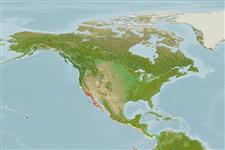Gastropoda |
Trochida |
Turbinidae
Environment: milieu / climate zone / ระดับความลึก / distribution range
นิเวศวิทยา
; ระดับความลึก 1 - 100 m (อ้างอิง 121891). Subtropical; 34°N - 24°N, 120°W - 111°W
Eastern Pacific: from Point Conception, California, USA to Bahia Magdalena, Mexico.
Length at first maturity / ขนาด / Weight / Age
วัยเจริญพันธุ์: Lm ? range ? - ? cm Max length : 15.0 cm SHD เพศผู้/กระเทย; (อ้างอิง 121668)
Coastal (Ref. 121668). It is found on rocks, usually in kelp beds, from low intertidal to a depth of 21 meters (Ref. 865). Also in subtidal habitats (Refs. 121666, 121667) and rocky reefs (Ref. 121668). Herbivorous (Refs. 121666, 121667), primarily feeds on the giant kelp Macrocystis pyrifera; also consumes a variety of fleshy and calcareous macroalgae (Ref. 121667).
Life cycle and mating behavior
วัยเจริญพันธุ์ | การสืบพันธุ์ | การวางไข่ | Eggs | ความดกของไข่ | Larvae
Members of the order Patellogastropoda are mostly gonochoric and broadcast spawners. Life cycle: Embryos develop into planktonic trocophore larvae and later into juvenile veligers before becoming fully grown adults.
Bisby, F.A., M.A. Ruggiero, K.L. Wilson, M. Cachuela-Palacio, S.W. Kimani, Y.R. Roskov, A. Soulier-Perkins and J. van Hertum 2005 Species 2000 & ITIS Catalogue of Life: 2005 Annual Checklist. CD-ROM; Species 2000: Reading, U.K. (อ้างอิง 19)
IUCN Red List Status
(อ้างอิง 130435: Version 2025-1)
CITES status (อ้างอิง 108899)
Not Evaluated
CMS (อ้างอิง 116361)
Not Evaluated
Threat to humans
Human uses
การประมง: การค้า
| FishSource |
เครื่องมือ
ข้อมูลเพิ่มเติม
Life cycleการสืบพันธุ์วัยเจริญพันธุ์ความดกของไข่การวางไข่EggsEgg developmentLarvae Human RelatedStamps, coins, misc.
แหล่งที่มาจากอินเตอร์เน็ต
Estimates based on models
Preferred temperature
(Ref.
115969): 15.9 - 24.4, mean 18.6 (based on 60 cells).
ความสามารถในการกลับคืนสู่ปกติ
ขนาดกลาง, เวลาต่ำสุดที่จะทำให้ประชากรเพิ่มขึ้นเป็น 2 เท่าใช้เวลา 1.4 - 4.4 ปี (K=0.24).
Fishing Vulnerability
Low to moderate vulnerability (34 of 100).
Price category
Unknown.
